|
|
Recent Development of the Transformation from Amorphous Carbon to Graphene Method via Metal Catalyst
LI Han-Chao, LIU Pan-Pan, SUN Li-Li, KE Pei-Ling, CUI Ping, WANG Ai-Ying
2018 Vol. 33 (6): 587–595
 Abstract
Abstract(
973 )
 HTML
HTML(
22)
 PDF
PDF(5703KB)(
1554
)
Graphene has drawn wide attention owing to its excellent properties since the discovery in 2004. There are many methods to produce graphene so far but many challenges still exist in producing scalable and high quality graphene. Thus, preparation of graphene should be further explored. Amorphous carbon and graphene are two allotropes of carbon. As one kind of solid carbon source, amorphous carbon could also be used to produce graphene. The preparation of graphene from amorphous carbon via metal catalyst has aroused much interest. Here, the advantages of using amorphous carbon as solid carbon source, to get high quality and large size graphene via metal catalyst in recent years are summarized. Several influence factors, such as metal sort, annealing temperature, the ratio of amorphous carbon to metal, have been discussed elaborately. Meanwhile, transformation mechanism from amorphous carbon to graphene has been reviewed and summarized simultaneously. Finally, the prospect of this novel fabrication method for graphene was put forward.
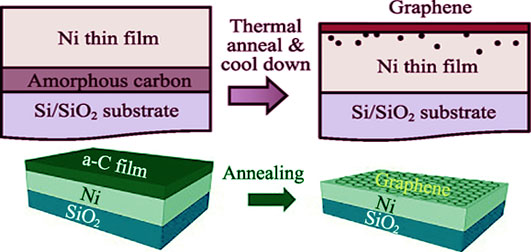
|
|
|
Fabrication and Mechanical Property of W-Y2O3 Composites and Graded material
WANG Shi-Yang, FU Yu-Dong, CHEN Lei, WANG Yu-Jin
2018 Vol. 33 (6): 596–602
 Abstract
Abstract(
616 )
 HTML
HTML(
4)
 PDF
PDF(1142KB)(
1124
)
W-Y2O3 composite with the gradient variation of volume content of Y2O3 was fabricated by pressureless sintering process. Phases and microstructure of W-Y2O3 composite were characterized. Fracture mechanism was explored by means of the measured results of mechanical properties and fracture morphology. Distribution of thermal stress in W-Y2O3 graded material during sintering is simulated by finite element method, while feasibility of composition content and structure of each layer are analyzed, then W-Y2O3 graded material is successfully fabricated by this process. The results show that the mechanical properties of W-Y2O3 composite decrease with the increment of volume content of Y2O3, which is mainly contributed to the effects of inherent strength of composed phase, porosity and grain size. Finally, faultless W-Y2O3 graded material with high quality of interface bonding can be fabricated by reasonable design of gradient layers.
|
|
|
Preparation and Property of MXene/Copper Alloy Composites
SI Xiao-Yang, CHEN Fan-Yan, DENG Qi-Huang, DU Shi-Yu, HUANG Qing
2018 Vol. 33 (6): 603–608
 Abstract
Abstract(
1312 )
 HTML
HTML(
35)
 PDF
PDF(1046KB)(
1666
)
Cu/Ti3C2Tx composites with Ti3C2Tx content of 5vol%, 10vol% and 20vol% were prepared by using a molecular-level mixing process and spark plasma sintering (SPS). Influence of Ti3C2Tx content on electrical, mechanical and tribological properties was investigated. The result showed that relative density and electrical conductivity of Cu/Ti3C2Tx composites gradually decreased with the Ti3C2Tx content increase, while the tensile strength of Cu/Ti3C2Tx composites increased at first and then decreased. When the Ti3C2Tx content was 5vol%, the tensile strength of Cu/ Ti3C2Tx composites increased by 43% than that of pure copper. Tribological properties of Cu/ Ti3C2Tx composites were enhanced by the addition of Ti3C2Tx. When the Ti3C2Tx content was 10vol%, the wear rate of Cu/ Ti3C2Tx composites was 2.55×10-7 mm3/(N·m), which was one magnitude lower than that of pure copper.
|
|
|
Evaluating Damage Evolution of Three-dimension Needled C/SiC Composite Based on Acoustic Emission Signal Analysis
HUANG Xi-Peng, WANG Bo, YANG Cheng-Peng, PAN Wen-Ge, LIU Xiao-Ying
2018 Vol. 33 (6): 609–616
 Abstract
Abstract(
657 )
 HTML
HTML(
6)
 PDF
PDF(1852KB)(
1108
)
Static tensile test of three dimension needled C/SiC composite material (3D-N C/SiC) was carried out at room temperature and damage processes of the composite was monitored online by an acoustic emission (AE) instrument. Noise information in the AE signals was removed according to Wavelet theory, and K-means clustering was used to analyze the AE signals. Combined with SEM observation, five damage modes were found during the tension: matrix cracking, interfacial debonding, interfacial sliding, individual fiber breakage, and fiber bundle rupture. The damage signal of 3D-N C/SiC composite contained three main frequencies at 240, 370 and 455 kHz, corresponding to interface damage, matrix damage and fiber fracture, respectively. Damage evolutionary mechanism was proposed through AE events and cumulative energy variation with loading time.
|
|
|
Preparation of Al2O3/TiO2 Composite film with High Specific Capacitance by Surface Self-assembly Method
WANG Jing-Ping, CHENG Fang-Yuan, DU Xian-Feng, XU You-Long
2018 Vol. 33 (6): 617–622
 Abstract
Abstract(
620 )
 HTML
HTML(
8)
 PDF
PDF(1982KB)(
1103
)
For anodized aluminum, the enhancement of the specific capacitance foils by increasing dielectric constant is one of the most common methods to meet the requirements of miniaturization and lightweight of aluminum electrolytic capacitors. In this study, surface self-assembly method was used to introduce sulfonic acid group to graft the surface of aluminum foil for changing its electrical properties. Electrostatic repulsion between surface of aluminum foil and colloidal particles of titanium dioxide was changed to electrostatic forces due to the existence of sulfonic acid group, which dramatically enhanced the deposition of titanium dioxide on the surface of the aluminum foil. After heat treatment and anodic oxidation of aluminum foil, the Al2O3/TiO2 compounds with high dielectric constant on the surface of aluminum foil were prepared successfully. Comparing with those without TiO2 coating, the content of Ti on the surface of anodized aluminum foil prepared by surface self-assembly method increased by 30 times while the specific capacitance of anodized aluminum foil was enhanced by 44.26% at the withstanding voltage of 400 V. Therefore, anodized aluminum foil with a high specific capacitance prepared by above method exhibits great potential in commercial application of aluminum electrolytic capacitor in the future.
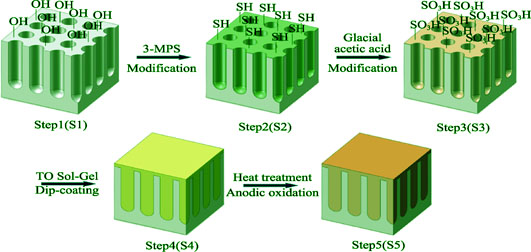
|
|
|
Core-shell Structured Hydroxyapatite/Mesoporous Silica Nanoparticle: Preparation and Application in Drug Delivery
SONG Jing-Jing, CHEN Bo, LIN Kai-Li
2018 Vol. 33 (6): 623–628
 Abstract
Abstract(
1001 )
 HTML
HTML(
16)
 PDF
PDF(1449KB)(
1210
)
Core-shell nanoparticle is a kind of composite nanomaterials with unique structure and properties, which has important application prospects in the fields of catalysis, biomedicine and photonic crystal, etc. A new kind of materials, core-shell structured HAp@mSiO2 nanoparticles with mesoporous were prepared by improved Stöber coating method using hydroxyapatite (HAp) nanoparticles as core and cetyltrimethylammonium bromide (CTAB) as mesoporous template. By controlling concentration of tetraethyl orthosilicate (TEOS) and its hydrolysis and condensation kinetics, the thickness of mSiO2 shell coating on the core HAp surface could be well regulated. The results of TEM, EDS, XRD, FT-IR, and BET testing show that the prepared HAp@mSiO2 nanoparticles have the characteristics of high specific surface area, narrow pore size and uniform distribution. And using the Ibuprofen as model drug, the prepared materials were tested for drug adsorption and release experiments. It is found that the obtained core-shell structured materials also have good drug control properties and pH response characteristics, and can effectively control the drug release rate and release amount through altering the mSiO2 shell thickness.
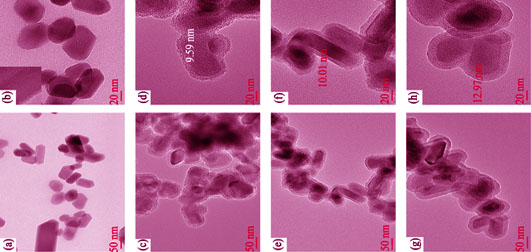
|
|
|
CTAB on Synthesis and Pore Structure of Hierarchical Zeolite
LI Hong-Ji, ZHOU Xiao-De, ZHANG Jian-Min, YANG Jing, WANG Fa-Liang, WANG Xiang-Yang
2018 Vol. 33 (6): 629–634
 Abstract
Abstract(
795 )
 HTML
HTML(
14)
 PDF
PDF(960KB)(
1265
)
Hierarchical zeolite was successfully synthesized with pretreated attapulgite (Si-ATP) by dual-template in one pot. Influence of the amount of structure-directing agent, hexadecyl trimethyl ammonium bromide (CTAB), on hierarchical pore structure and crystal morphology was systematically investigated. The results showed that the hierarchy factor (HF) had a good linear dependence on CTAB amount when it was between 0.01 and 0.03 g or 0.05 and 0.07 g. XRD revealed that the crystal morphology transferred from ZSM-5 to (H)ZSM-11 when CTAB amount ranged from 0.03 to 0.05 g. These results indicated that the ratio of micropore and mesopore could be controlled by CTAB amount when preparing hierarchical zeolites by this method. (H)ZSM-11 zeolites, prepared with 0.05 g of CTAB, exhibited a high specific surface area (SBET=432.02 m2/g), a large total volume (Vtot=0.40 cm3/g), and an adsorption capacity of methylene blue (MB) (366.45 mg/g). Therefore, the mesoporous pore built by CTAB is beneficial for adsorbing of macromolecules.
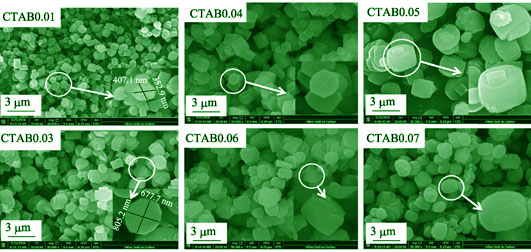
|
|
|
Zn1-xMgxO: Band Structure and Simulation as Window Layer for CdTe Solar Cell by SCAPS Software
HE Xu, REN Sheng-Qiang, LI Chun-Xiu, WU Li-Li, ZHANG Jing-Quan, DU Zheng
2018 Vol. 33 (6): 635–640
 Abstract
Abstract(
891 )
 HTML
HTML(
12)
 PDF
PDF(644KB)(
1371
)
In this paper, the band structure of Zn1-xMgxO(ZMO) alloy with different Mg compositions by using first-principles calculations with GGA+U method was studied. The calculation results show that position of conduction band offset and Fermi level of Zn1-xMgxO move towards the vacuum level while the band gap becomes wider with the increasing Mg concentration. Based on theoretical calculation results of ZMO, ZMO/CdTe, CdS/CdTe solar cells were modeled using SCAPS software and its device performances were simulated and analyzed in detail. The results indicate that the conversion efficiency of CdTe solar cell with ZMO is higher than that of solar cell with CdS due to the high open circuit voltage and short circuit current density when x in Zn1-xMgxO is in the range of 0-0.125. Efficiency of CdTe solar cells with ZMO reaches 18.29% because the recombination decreases obviously resulting from appropriate conduction band offset about 0.13 eV at ZMO/CdTe interface. These data provide a theoretical guidance for design and fabrication of high efficiency CdTe solar cells.
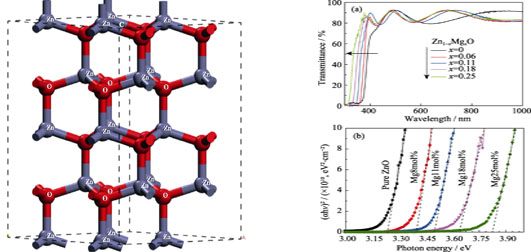
|
|
|
Cooperative Effect of Carbon Nanotubes and Dimethyl Sulfoxide on PEDOT:PSS Hole Transport Layer in Planar Perovskite Solar cells
XU Shun-Jian, XIAO Zong-Hu, LUO Xiao-Rui, ZHONG Wei, LOU Yong-Ping, OU Hui
2018 Vol. 33 (6): 641–647
 Abstract
Abstract(
925 )
 HTML
HTML(
18)
 PDF
PDF(1573KB)(
1136
)
Poly(3,4-ethylenedioxythiophene):poly(styrene sulfonate) (PEDOT:PSS) film is commonly used as hole transport layer in planar perovskite solar cells (PSCs). To further strengthen the charge transport within PEDOT:PSS film and boost the growth of the perovskite crystal on PEDOT:PSS film, carbon nanotubes (CNTs) and dimethyl sulfoxide (DMSO) were simultaneously used as additives to prepare the co-modified film of CNT-DMSO-PEDOT:PSS. Results demonstrate an advantageous cooperative effect of CNTs and DMSO on the co-modified film. The dispersed CNTs with a grid-like structure throughout PEDOT:PSS matrix plays dual roles: to promote the perovskite crystal growth on co-modified surface and to reduce the sheet resistance of the co-modified film, while DMSO improves the conductivity of the co-modified film and controls the loss of CNTs from the co-modified film. Due to the cooperative effect, co-modified film is significantly more capable to collect, transport charges and enhance the perovskite layer growth with larger grains on its surface than that with pristine PEDOT:PSS film or PEDOT:PSS films modified by a single additive of CNT or DMSO, CNT-PEDOT:PSS or DMSO-PEDOT:PSS. Meanwhile, the co-modified film maintains high transparency with a transmittance of 88.8% at 550 nm. As a result, the PSCs of co-modified film has a hig power conversion efficiency of 5.75% in contrast to the devices based on the CNT-PEDOT:PSS (3.01%), DMSO-PEDOT:PSS (2.03%) and pristine PEDOT:PSS (1.30%) films.
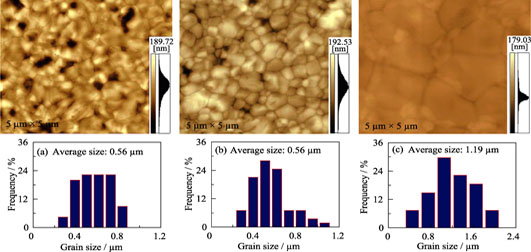
|
|
|
Hydrogen Generation from Hydrolysis of Sodium Borohydride Using Co3O4 Hollow Microspheres Synthesized with Yeast Template
WEI Lei, MA Mai-Xia, LU Yan-Hong, WANG Dong-Sheng, ZHANG Su-Ling, ZHAO Di, MA Wei-Pan
2018 Vol. 33 (6): 648–652
 Abstract
Abstract(
665 )
 HTML
HTML(
2)
 PDF
PDF(3859KB)(
983
)
Co(OH)3 was firstly deposited on the surface of yeast template, and then Co3O4 hollow microspheres (denoted as Co3O4-HM) were successfully achieved by calcination. Co3O4-HM were employed as catalyst precursor for hydrogen generation from the hydrolysis of sodium borohydride. Field-emission scanning electron microscopy (FE-SEM) and X-ray diffraction (XRD) were used for morphology and phase analyses, respectively. When NaBH4 concentration is 10wt% in alkaline solution, the as-synthesized Co3O4-HM present high hydrogen generation rate up to 2140 mL/(min·g) at 25℃, which is almost nine times of that of Co3O4 synthesized without yeast template at the same condition. Furthermore, the Co3O4-HM show excellent stability for long-term storage.
|
|
|
KOH Alkalized Fe3N Nanoparticles on Electrocatalytic Hydrogen Evolution Reaction
WANG Hui, YU You-Xing
2018 Vol. 33 (6): 653–658
 Abstract
Abstract(
717 )
 HTML
HTML(
19)
 PDF
PDF(746KB)(
1160
)
Surface modification of Fe3N nanoparticles by KOH solution under electrification conditions was carried out, and effect of alkalization on the catalytic performance of Fe3N nanoparticles was investigated. Morphology and composition of Fe3N nanoparticles and alkalized Fe3N nanoparticles were characterized by XRD, TEM, EDX, XPS, Raman spectra, and Fourier Transform Infrared spectroscopy. Electrocatalytic hydrogen evolution reaction (HER) performance of Fe3N nanoparticles and alkalized Fe3N nanoparticles was analyzed by time-current curve, linear sweep voltammetry, Tafel slope, AC impedance method, and CV curve. It was found that, for alkalized Fe3N nanoparticles, their average grain sizes decreased from (80±10) nm to (70±10) nm. Their morphology changed from broken chain structure to elliptical structure, while their the phase changed partly from ε-Fe3N to α-Fe2O3, which brought about more exposed electrocatalytic activity sites when compared with the Fe3N before alkalization. Overpotential at 10 mA/cm2 the alkalized Fe3N nanoparticles was reduced from 0.429 V to 0.204 V and Tafel slope was reduced from 103 mV/dec to 95 mV/dec. Low opening voltage, small Tafel slope, low over-potential, small AC impedance and larg chemically active surface area were achieved by the alkalized Fe3N nanoparticles, demonstrating that alkalized Fe3N is a promising excellent electrocatalyst for water splitting.
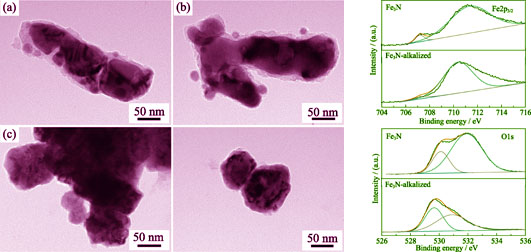
|
|
|
Au Nanoparticles (NPs) Surface Plasmon Resonance Enhanced Photocatalytic Activities of Au/Bi2WO6 Heterogeneous Nanostructures
WANG Dan-Jun, WANG Chan, ZHAO Qiang, GUO Li, YANG Xiao, WU Jiao, FU Feng
2018 Vol. 33 (6): 659–666
 Abstract
Abstract(
928 )
 HTML
HTML(
13)
 PDF
PDF(6564KB)(
1082
)
Novel visible-light-responsive Au/Bi2WO6 heterogeneous nanostructures were successfully prepared through in situ growth gold nanoparticles (Au NPs) on the second-structural nanosheets of three-dimensional (3D) Bi2WO6 via a facile photoreduction process. XRD, FE-SEM, HR-TEM, FT-IR, XPS, and UV-Vis-DRS spectra were employed to investigate the phase composition, morgphology and light-absorption properties of as-preapared samples. Rhodamine B(RhB) and phenol were selected as model pollutants to evaluate photocatalytic activities of samples. The experimental results reveal that the as-prepared Au/Bi2WO6 heterogeneous nanostructures exhibit much higher photocatalytic activities than pure Bi2WO6 for dye degradation. It is also revealed that 1.5at%Au/Bi2WO6 sample exhibit the best photocatalytic activities in the degradation process of RhB and phenol, the apparent rate constant is about 1.5 and 2.2 times as high as that of pure Bi2WO6 under visible light irradiation, respectively. Moreover, the trapping experiments results show that photogenerated hole (h+) and ·O2- serve as the main active species for the photodegradation of RhB over Au/Bi2WO6 heterogeneous nanostructures. The enhanced photocatalytic efficiencies of Au/Bi2WO6 heterogeneous nanostructures are attributed to the charge transfer from Bi2WO6 to the deposited Au NPs as well as their surface plasmon resonance (SPR) absorption, which enhance the migration efficiency of the electron-holes and retard the recombination of electrons-hole pairs. Au NPs decorated Bi2WO6 heterogeneous nanostructures have considerable potential applications in solar-driven wastewater treatment.
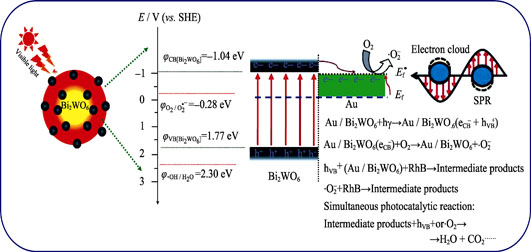
|
|
|
Synthesis, Characterization and Property of a New UV Nonlinear Optical Crystal KNa5Ca5(CO3)8
CHEN Qiao-Ling, LUO Min, LIN Chen-Sheng
2018 Vol. 33 (6): 667–672
 Abstract
Abstract(
530 )
 HTML
HTML(
5)
 PDF
PDF(1401KB)(
1097
)
A new carbonate nonlinear optical (NLO) material, KNa5Ca5(CO3)8, was successfully synthesized by mild hydrothermal method. It crystallizes in hexagonal space group (P63mc) with lattice parameters a=b=1.00786(4) and c=1.26256(8) nm (Z=2). Structure of KNa5Ca5(CO3)8 can be described as standing-on-edge [CO3] groups connecting the adjacent infinite [CaCO3]∞ layers in the a-b plane to construct a framework with four types of channels running parallel to [010]. K, Na and [Na0.67Ca0.33] atoms reside in the tunnels. In the structure, the ?at-lying [CO3] groups in two successive layers present an opposite orientation. This arrangement is negative for NLO susceptibilities. The macroscopic of SHG effects, however, originated from the standing-on-edge [CO3] group along c axis. It is regrettable that the standing-on-edge [C3O3] and [C4O3] groups are almost arranged oppositely to the c direction, which weakens the SHG contribution from the standing-on-edge [CO3] groups. Measurement of second harmonic generation (SHG) by the method adapted from Kurtz and Perry indicates that the compound is phase-matchable in visible region and exhibit moderate SHG response about 1.2 times higher than that of KH2PO4. In addition, UV-Vis-NIR diffuse reflectance spectral measurements indicate that KNa5Ca5(CO3)8 has a large optical gap about 5.95 eV. Moreover, first-principles electronic structure calculations show that the CO3 groups play an important role in the total SHG response. Therefore, our data suggests that the new compound as NLO material may have potential applications in the UV region.
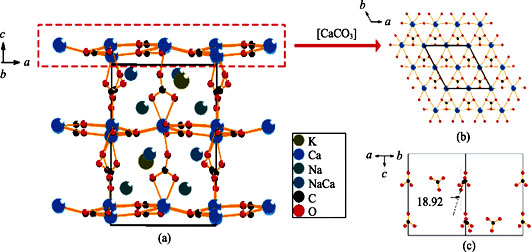
|
|
|
Preparation and Infrared Luminescence of Transparent Ni2+-doped ZMAS Glass-ceramics
JIAO Zhi-Wei, DUAN Cui-Cui, ZHOU Wei, LIU Feng-Bin, YANG Yue, ZHAO Pan, XIANG Jun-Fan
2018 Vol. 33 (6): 673–677
 Abstract
Abstract(
671 )
 HTML
HTML(
6)
 PDF
PDF(604KB)(
998
)
Transparent Ni2+-doped ZnO-MgO-Al2O3-SiO2 (ZMAS) system glass-ceramics with broadband infrared luminescence were prepared by heat-treatment of parent glass via melt quenching method. According to DTA results, glass transition temperature (Tg) and maximum crystallization temperature (Tc) of the as-prepared samples are 754℃ and 948℃, respectively. Glass-ceramics obtained from two different heat-treatment systems were characterized by X-ray diffraction, and crystallization behaviors and phase transitions were analyzed. The results show that transparent Ni2+-doped spinel-phase glass-ceramics can be obtained by using two-step heat-treatment process. Ultraviolet-visible absorption spectra and luminescence spectra of the prepared glass-ceramics were investigated. The results indicate that tetrahedral and octahedral sites Ni2+ ions coexist in spinel microcrystals of Ni2+-doped ZMAS system glass-ceramics. The broadband infrared luminescence centered at 1324 nm with full width at half maximum (FWHM) of about 490 nm was observed from the samples. Mechanism underlined these phenomena is attributed to the transitions of 3T2g(3F)→3A2g(3F) of octahedral six-folded Ni2+ in the solid solution of spinel structure of Zn/MgAl2O4. These data confirm that the glass-ceramics may have potential applications for photonic devices such as super broadband optical fiber amplifiers.
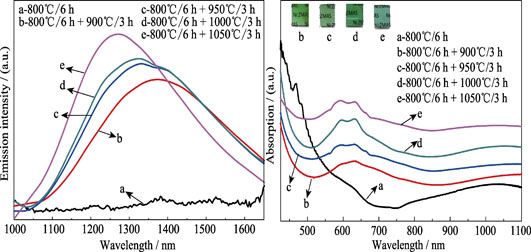
|
|
|
Single-mode Chalcogenide Fiber: Fabrication and Supercontinuum Generation
CHEN Wei, ZHU Ning, ZHAO Zhe-Ming, ZHANG Pei-Qing, WANG Xun-Si, DAI Shi-Xun
2018 Vol. 33 (6): 678–682
 Abstract
Abstract(
523 )
 HTML
HTML(
2)
 PDF
PDF(1120KB)(
890
)
Chalcogenide (ChG) glasses are well known for their unique characteristics in infrared (IR) and strong nonlinearities, endowing them as promising candidates for Mid-IR supercontinuum generation (SCG). Here, step-index As-S fiber with a small core was fabricated via twice-extrusion method. The fiber is single-mode when the propagating light wavelength is longer than 6.3 μm. Loss baseline of the step-index fiber is about 1 dB/m. Zero-dispersion-wavelength (ZDW) of the fiber is located at near 5.2 μm. By pumping the fiber with a femtosecond laser of optical parametric amplifier (OPA), Mid-IR SCG was investigated in multi-length scale fibers with different pumping wavelengths. Launching intense ultra-short pulses (~150 fs, 1 kHz) into a 23-cm-long fiber, Mid-IR SC spanning from 1.5 μm to 8.7 μm can be observed when pumping at a central wavelength of either 4.5 μm or 5.2 μm, corresponding to absorption peak at normal dispersion regime and ZDW, respectively. Besides, the spectra spanning would be extended in shorter fiber length under optimized pumping laser power. For ChG glass fiber, shorter fiber length is much more suitable for SC spanning than longer fiber length.
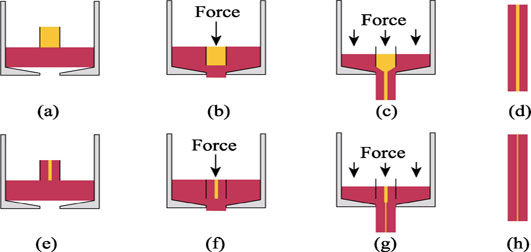
|
|
|
Property of A/B Sites Substituted Bismuth Sodium Titanate Based Piezoelectrics
LIU Xiao, XU Xiao-Min, DU Hui-Ling
2018 Vol. 33 (6): 683–687
 Abstract
Abstract(
558 )
 HTML
HTML(
6)
 PDF
PDF(1804KB)(
903
)
Bi and Co substituted stoichiometric bismuth sodium titanate based lead free piezoelectrics, (Bi0.5+x/2Na0.5-x/2)0.94Ba0.06Ti1-xCoxO3, were prepared by using a solid-state reaction method. The effects of combined A/B sites defects on polarization hysteresis and electric-induced-strain properties of materials were explored. It is shown that single pseudocubic structure is revealed in all samples. Substitution leads to downward shift of the ferroelectric-relaxor transition temperature and increase in strain. Meanwhile, the samples exhibit high strain of 0.458% and inverse piezoelectric coefficient d33* of 770 pm/V, accompanied by an increased fraction of relaxor phase during fatigue test. The anomalies in temperature dependent dielectrics and hysteresis loops are highly related to the formation of A/B sites defect dipoles which mediated by oxygen vacancies in stoichiometric ceramics.
|
|
|
Thermal Property of Y4.67(SiO4)3O Ceramic Sintered from Hydrothermally Synthesized Spindle-like Y4.67(SiO4)3O Apatite Crystallites
WANG Qing-Gang, HUANG Jian-Feng, ZHOU Lei, WU Wan-Chen, CAO Li-Yun
2018 Vol. 33 (6): 688–692
 Abstract
Abstract(
669 )
 HTML
HTML(
4)
 PDF
PDF(6340KB)(
1001
)
Spindle-like Y4.67(SiO4)3O apatite crystallites composed of numerous nanoparticles with a mean diameter of about 50 nm were synthesized via a facile hydrothermal method at 503 K for 12 h. To the best of our knowedge, the thermal properties of the spindle-like Y4.67(SiO4)3O apatite crystallites was firstly reported. Their phase composition, microstructure, formation mechanism were investigated. Results show that hydrothermal temperature greatly influences the crystal phase composition and the crystal morphology. In addition, the obtained Y4.67(SiO4)3O ceramics possess low thermal conductivity and a relatively high thermal expansion coefficient, which make them a promising candidate material for environmental/thermal barrier coatings.
|
|
|
Simulation on Potassium Ion Concentration Profile of Engineered Stress Profile Glass by FDTD Method
ZHENG Guo-Yuan, LI Jia-Cheng, SONG Li-Xin, ZHANG Tao
2018 Vol. 33 (6): 693–698
 Abstract
Abstract(
708 )
 HTML
HTML(
4)
 PDF
PDF(438KB)(
924
)
Strength of Engineered Stress Profile glass has been proved narrowly distributed owing to its particular exchanged ion profile. In order to predict the K+ concentration profile, Finite-Difference Time-Domain method was introduced to simulate the diffusion processes. Simulation procedures were conducted based on detected diffusion coefficients, surface concentrations, and ion profile subjected to single step ion exchange. The calculated results show a reasonable agreement with the experimental measurements (Energy Dispersive Spectroscopy). According to the simulation results, the relation between K+ profile and strength performance were interpreted.
|
|